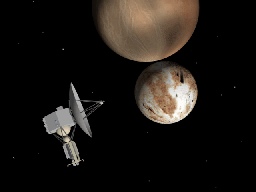
Courtesy of the Solar and Heliospheric Group, University of Michigan.
More on Recent Coronal Mass Ejection
News story originally written on June 16, 1998
During a period of about two days in early May, 1998, the ACE spacecraft was immersed in plasma associated with a coronal mass ejection (CME). The SWICS instrument on ACE, which determines unambiguously the mass and charge of solar wind ions with high time resolution, has produced a new and very exciting data set from this event. These data carry a wealth of information on the origin and thermal history of the CME ejecta and have the potential of being the missing link between solar observations and in situ plasma observations. Here, we concentrate on the iron charge state distribution, which has been measured once per hour during the entire CME period. These distributions are imprints of the electron temperature distribution function within a few solar radii from the solar surface where the ejecta were accelerated. During this event the observed charge states range from the very rare Fe3+, during phases of very cold plasma, to Fe16+, when the plasma is extraordinarily hot, indicating an enormous range in electron temperatures from 105 K to several 106 K.
The movie shows the time history of this event: After a period of standard slow solar wind, a very hot charge state distribution arrives just after the begining of Day 122. This very hot component is followed near the end of Day 122 by one of the coldest components ever measured in situ, including what is (to our knowledge) the first observation of Fe3+ in solar wind. After about 12 hours of this cold plasma, the "hot" Fe16+ shows up again for a short time. Notice, that the transitions between "hot" and "cold" components are not abrupt: there are clearly time-periods where very "cold" Fe6+ and very "hot" Fe16+ co-exist.
These data provide a unique view of a CME associated with a cold plasma component, perhaps originating from an erupted filament. They provide valuable information about the CME between the time of solar observations with imaging instruments on SOHO and in situ plasma observations at 1 AU, i.e. electron and proton distributions measured by ACE/SWEPAM.
Text contributed by S. Hefti and T. H. Zurbuchen, University of Michigan.













